Thinking Like a CFO: Prevention Pays, Analysis Shows
A sophisticated financial study of the costs and payoff of preventive maintenance at one large company reveals a tremendous savings
Justifying investments in physical assets is often a difficult challenge for facility executives. That’s especially true when the decision involves keeping existing systems in good working order by investing in preventive maintenance. But a detailed analysis conducted at one large company — based on an assessment of the value of preventive maintenance in terms of key financial ratios — shows that an investment in prevention can have a tremendous payoff.
Over the years, preventive maintenance has been more popular in principle than in practice. One scarcely can argue with the idea of keeping equipment well maintained to extend its expected life and avoid future repair costs. But the economic value of that strategy is difficult to determine.
For example, repair and maintenance account for about 15 percent of total expenses, according to the Building Owners and Managers Association (BOMA) Experience Exchange Report for the year 2000. Although the report does not distinguish between repairs and preventive maintenance, estimates suggest that the latter may account for between 30 percent and 50 percent of repair and maintenance costs, or from 4.5 percent to 7.5 percent of annual operating costs.
Although not an overwhelming number, this is a significant amount. Can it be justified?
To answer this question, an analysis of preventive maintenance was conducted at a large telecommunications firm. The corporate real estate managers of the company believed that their preventive maintenance program had been significantly underfunded for years. They wanted to ask corporate management for additional funds but needed financial backup to support their request. The managers had to show a significant return on any proposed investment.
Building a Financial Model
The goal of the analysis was to develop a system that would quantify the net present value and return on investment of investing in preventive maintenance. The analysis identified:
- Actual cost of preventive maintenance
- Effects of preventive maintenance on expected useful life
- Cost of repair/corrective maintenance
- Frequency of required repairs when equipment is not maintained
- Cost of replacing equipment
- Effect of preventive maintenance on energy consumption
- Expected useful life of equipment
Approximately 12 percent of the company’s entire portfolio of 119 million square feet was surveyed to identify:
- Type of equipment in each building (e.g., chillers)
- Age of equipment
- Amount of equipment (e.g., number of chillers)
- Annual preventive maintenance expenditures for equipment
- Size of equipment (e.g., tons)
The team proceeded on the assumption that this proxy portfolio was representative of the full corporate portfolio. Average size and age were calculated for each piece of equipment, limiting the study to the 15 pieces of equipment shown in Table 3.
The most difficult information to obtain was the effect of maintenance on the expected useful life of equipment. The team studied textbooks, spoke with industry experts and manufacturers, and reviewed articles on preventive maintenance, but few sources provided estimates of the amount of life added. The study settled upon the most conservative estimates from equipment manufacturers, reference books and sales material.
The team used the data to build a financial model. The assumptions built into the model are shown in Table 4. (Because lost revenue due to downtime couldn’t be quantified, zero downtime was used in the model.)
Here is a simple illustration of the type of analysis conducted. Replacing a hypothetical 10-year-old, 7-horsepower air compressor would cost $32,900. Is an investment in preventive maintenance justified?
Information obtained by the team showed that the compressor should last 20 years with proper preventive maintenance but only 16 years without it. Proper preventive maintenance will cost $472 per year. Repairing the compressor will cost $944 per incident. If maintained properly, it will need to be repaired once every four years. If not, repairs will be needed every three years. Assuming a time frame of 25 years, is an investment in preventive maintenance justified?
The cost to repair the equipment translates into $236 per year with preventive maintenance; without it, that cost comes to $315 per year. With preventive maintenance, the compressor will need to be replaced in year 10; otherwise, it will have to be replaced twice, in year 6 and year 20. Comparing the two scenarios indicates that the preventive maintenance scenario has a net present value of $6,359.
If the time period is extended to 30 years, the compressor will need to be replaced twice in the preventive maintenance scenario. This reduces the NPV to $4,338. In either case, the investment in preventive maintenance is clearly justified economically.
For purposes of simplicity, this example does not consider inflation, residual value, energy or lost revenue from downtime. If residual value (how much the compressor is worth after year 25) is factored in, for example, the NPV would decrease. But each of the other factors would cause an increase in NPV that would more than compensate for the effect of the residual.
Three Scenarios
The team considered three different preventive maintenance programs or scenarios.
Scenario 1 involved no preventive maintenance. Obviously, the cost of preventive maintenance is zero in this scenario. The cost of repairs, the cost of energy and the frequency of equipment replacement will increase, however, because the equipment will not be properly maintained. The amount of energy degradation and expected life degradation is based on the research previously mentioned. It is also assumed that the frequency of repairs will increase in an amount similar to the expected-life degradation. For example, the research indicated that, even with proper maintenance, a compressor would need to undergo minor repair every four years. The model assumes that this repair frequency will increase by 20 percent when the compressor is not properly maintained, adding repair costs over the life of the compressor.
Scenario 2 was based on the company’s current preventive maintenance levels. In this scenario, the cost of preventive maintenance represents the actual amount spent by the company. For most of the 15 types of equipment, significantly less was being invested than recommendations based on benchmarks collected by the team. In these cases, the amount of energy and expected-life degradation was extrapolated between the no-preventive-maintenance scenario and the industry benchmark scenario. For example, an air compressor’s expected life will decrease by 20 percent if not maintained, and proper maintenance will cost $472 per year. If the company spent $236 (half the recommended amount) on compressor maintenance, the expected life would decrease by 10 percent instead of 20 percent.
Scenario 3 used industry benchmark levels of preventive maintenance. In that scenario, the model assumes that the company spends the industry benchmark amount on preventive maintenance activities. This scenario also assumes that the equipment will last its full expected life and that energy performance will not degrade over the life of the equipment.
For each scenario, the team calculated the yearly cost of operating a piece of equipment and built a timeline of expenditures. The cost consisted solely of energy, repair maintenance, preventive maintenance and equipment replacement. To calculate the cost of energy, the model assumes an average figure for annual operating hours and an average efficiency. In scenarios 1 and 2, efficiency was degraded based on the amount of preventive maintenance performed.
The average life of each piece of equipment was used to determine when the equipment would need to be replaced. For example, the average age of an air compressor in the company’s portfolio was 17 years. The expected useful life of an air compressor is 20 years with preventive maintenance, so in years 3 and 23 of the scenario 3 analysis, the compressor needed to be replaced. Without preventive maintenance (scenario 1), the expected useful life of the compressor is assumed to be 16 years, so for purposes of the study it needs to be replaced in years 1 and 17 of the analysis. (The actual compressors in the company’s portfolio may have received some preventive maintenance.)
Obviously, replacing equipment in later years is superior to replacing equipment in early years. The analysis indicates that the expense of replacement can be pushed out over time by properly maintaining the equipment.
For each piece of equipment, the net present value and return on investment of scenario 1 (no preventive maintenance) were compared to those for scenario 3 (industry benchmark preventive maintenance).
Scenario 2 (current preventive maintenance) was also compared to scenario 3 to determine the effect of increasing spending on preventive maintenance. The analysis also considered the portfolio as a whole by adding up all the expenditures and calculating an overall net present value and return on investment.
The results of the analysis were overwhelmingly positive: Compared to no preventive maintenance, an investment in preventive maintenance not only pays for itself but also produces a huge return.
At the portfolio level, the analysis indicated a net present value of $2 billion over a 25-year period for a $39-million-per-year ($0.33/sf.) preventive maintenance program. That represents a return on investment of 545 percent. The bulk of the return comes from increasing the useful life of equipment. Energy savings account for approximately 7 percent of the return.
A 545 percent ROI seems like a huge return, and it is. Consider, however, the cost of just one piece of equipment: a chiller. The average size of the company’s chillers was 350 tons. At $1,000 per ton, chillers would cost an average of $350,000 to replace.
Maintaining the chiller costs $5,500 per year, and proper maintenance adds years to the equipment’s life, avoiding the extremely large capital outlay needed to replace it. The longer the capital expense can be delayed, the higher the return on investment.
Maintaining all the equipment in the portfolio produces significant returns, which offers a powerful argument for the value of preventive maintenance and the dramatic impact it can have on real estate investments.




Wei Lin Koo is a vice president with Jones Lang LaSalle’s Strategic Consulting group. Tracy Van Hoy, P.E., is vice president of engineering and operations for the firm.
Related Topics:















